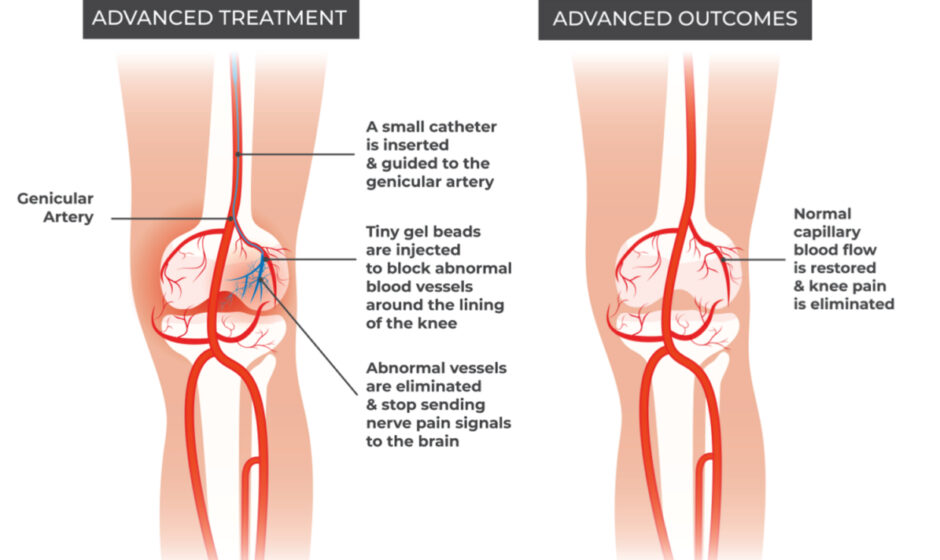Introduction to Genicular Artery Embolization
Genicular Artery Embolization (GAE) is an innovative interventional radiology procedure designed to provide relief from chronic knee pain, particularly in patients suffering from osteoarthritis or other degenerative conditions. The procedure involves selectively blocking specific arteries that supply blood to the painful areas of the knee joint. This results in reduced inflammation and pain relief, ultimately enhancing the quality of life for patients. Flowcare is dedicated to providing comprehensive information and support for those considering GAE as a treatment option.
Understanding the Anatomy of the Knee
To appreciate the significance of Genicular Artery Embolization, it is essential to understand the knee’s anatomy. The knee joint comprises bones, cartilage, ligaments, and synovial fluid, all of which play a crucial role in joint movement and stability. The genicular arteries, branching from the popliteal artery, supply blood to the knee joint and surrounding structures. When these arteries become involved in chronic inflammation, they can contribute to persistent pain and discomfort.
Why Choose Genicular Artery Embolization?
Chronic knee pain can significantly impact a person’s daily life, leading to decreased mobility and a reduced ability to perform routine activities. Traditional treatment options, such as medication and physical therapy, may provide temporary relief but often fail to address the underlying issue. Genicular Artery Embolization presents several advantages:
Minimally Invasive Procedure
GAE is a minimally invasive technique, which means it can be performed with small incisions and typically requires only local anesthesia. This results in reduced recovery times and lower risks of complications compared to traditional surgical methods.
Targeted Pain Relief
By selectively blocking the genicular arteries, GAE directly targets the source of pain, providing immediate and effective relief. This is particularly beneficial for patients who have not responded well to other treatments.
Quick Recovery Time
Most patients can return to their regular activities within a short period following the procedure. This quick recovery time allows individuals to regain their independence and improve their quality of life without prolonged downtime.
The Genicular Artery Embolization Procedure
The GAE procedure typically involves several key steps:
Pre-Procedure Evaluation
Before undergoing Genicular Artery Embolization, patients will have a thorough evaluation, including imaging studies like MRI or CT scans, to assess the extent of their knee condition. This evaluation helps the physician determine the appropriateness of the procedure and identify the specific arteries to be targeted.
Sedation and Anesthesia
On the day of the procedure, patients are given sedation to ensure comfort throughout the process. Local anesthesia is administered to the targeted area to minimize discomfort.
Catheter Insertion
A thin catheter is inserted into the femoral artery in the groin and guided through the vascular system to the genicular arteries. Real-time imaging is used to navigate and ensure precise placement.
Embolization Process
Once the catheter is in position, embolic agents—tiny particles or coils—are introduced to block the selected genicular arteries. This effectively reduces blood flow to the inflamed areas, alleviating pain.
Post-Procedure Monitoring
After the embolization, patients are monitored for a brief period to ensure there are no immediate complications. Most patients can go home the same day, although some may require an overnight stay for observation.
Recovery and Aftercare
Recovery following Genicular Artery Embolization is generally swift. Patients may experience mild discomfort or swelling, which can be managed with over-the-counter pain relief medications. Physical therapy may also be recommended to help regain strength and mobility.
Potential Risks and Complications
While GAE is considered safe, like any medical procedure, it carries some risks. Potential complications may include:
- Infection at the catheter insertion site
- Allergic reactions to contrast dye
- Temporary worsening of pain post-procedure
Patients should discuss any concerns with their healthcare provider to ensure they are fully informed before proceeding with the treatment.
Who Is a Suitable Candidate for GAE?
Genicular Artery Embolization may be an excellent option for patients suffering from:
- Chronic knee pain due to osteoarthritis
- Pain that has not improved with conservative treatments like medication or physical therapy
- Patients looking for a minimally invasive alternative to surgical options
A thorough evaluation by a qualified healthcare professional is essential to determine if GAE is the right choice.
The Role of Flowcare in Genicular Artery Embolization
At Flowcare, we prioritize patient education and support throughout the treatment process. Our team of experienced healthcare professionals is dedicated to providing comprehensive care, from the initial consultation through recovery. We understand that each patient’s experience is unique, and we strive to offer personalized treatment plans tailored to individual needs.
Patient Support and Education
Flowcare offers a wealth of resources to help patients understand their condition and the potential benefits of Genicular Artery Embolization. Our educational materials cover:
- Detailed information about the procedure
- Expected outcomes and recovery timelines
- Tips for managing pain and promoting healing post-procedure
Continuous Follow-Up Care
Following GAE, Flowcare remains committed to ensuring patients receive the necessary follow-up care. Regular check-ups and assessments help monitor recovery and adjust treatment plans as needed, ensuring optimal results.
Conclusion
Genicular Artery Embolization represents a promising solution for those struggling with chronic knee pain. Its minimally invasive nature and targeted approach provide a compelling alternative for patients seeking relief from persistent discomfort. With the support of Flowcare, individuals can navigate their treatment options confidently, regaining mobility and improving their overall quality of life.
If you or a loved one is suffering from knee pain, consider consulting with Flowcare to explore the potential benefits of Genicular Artery Embolization and take the first step toward a more comfortable, active life.



